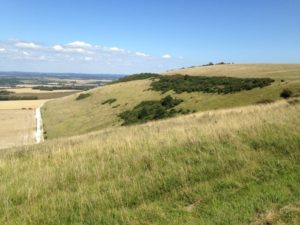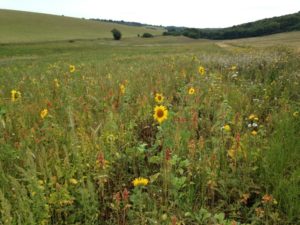Botanical survey and habitat condition assessment work was undertaken on more than 20 different land holdings between July 2015 and August 2016. The aim of the project was to collect data on the current ecological conditions of land under Higher Level Stewardship (HLS) which could be used to assess the the success of the scheme, and of scheme components in delivering its intended nature conservation objectives.
HLS is an agri-environment scheme scheme, now superseded by Countryside Stewarship; Higher Tier where landowner receive grants to enable them to manage high value habitats in support of nature conservation priorities. Each HLS agreement is made up of options which include the management prescriptions which are to be followed.
Some examples of the habitats surveyed are shown below.
Lowland Calcareous Grassland on the South Downs (West Sussex)
 A North facing chalk escarpment supported a large area of SSSI designated calcareous grassland notified for its important plant assemblages. This area was being managed under an HLS option: ‘maintenance of species-rich grassland’. Other grasslands in the area were being managed for creation or restoration of species- rich grassland.
A North facing chalk escarpment supported a large area of SSSI designated calcareous grassland notified for its important plant assemblages. This area was being managed under an HLS option: ‘maintenance of species-rich grassland’. Other grasslands in the area were being managed for creation or restoration of species- rich grassland.
The SSSI area was surveyed using a total of 20 stops spread evenly across the feature, 10 of which were recorded as full quadrats (including percentage cover) with the remainder taking the form of species lists only. The relevant CSM condition assessment form was completed for NVC communities CG5-Bromus erectus-Brachypodium pinnatum grassland and CG6-Avenula pratensis grassland. Striking species of chalk downland were encountered including Autumn Gentian and Round-headed Rampion.
Restoration of Species-rich Grassland and Ancient Wood-pasture (Somerset)
first. It consisted of many small, traditional fields which were under a restoration of species-rich grassland option. A total of 5 1mx1m quadrats were placed in each field and the percentage of each species recorded.
Species present included Betony (Stachys officinalis), Crested Dog’s Tail (Cynosurus cristatus), Devil’s Bit scabious (Succisia pratensis), and Ox-eye Daisy (Leucanthemum vulgare). An area of ancient wood-pasture in the Avon valley was also surveyed using 10mx10m quadrats. Trees included venerable specimens of Beech (Fagus sylvatica) and Oak (Quercus robur) and a variety of Whitebeam (Sorbus sp.). The site was being managed by grazing with rare breed native cattle.
Arable Landscape (Northamptonshire).
 A landscape with large scale arable fields was surveyed in Northamptonshire. A number of changes designed to increase the value of the farmland to biodiversity had been introduced under HLS. Options implemented included those for plain grass margins and floristically-enhanced grass margins to fields and wild bird seed mix plots.
A landscape with large scale arable fields was surveyed in Northamptonshire. A number of changes designed to increase the value of the farmland to biodiversity had been introduced under HLS. Options implemented included those for plain grass margins and floristically-enhanced grass margins to fields and wild bird seed mix plots.
Two linear transects of five quadrats spaced at ten metre intervals were recorded for each arable option surveyed. The floristically enhanced grass margins had had wildflower species introduced including Red Clover (Trifolium pratense), Bird’s-foot Trefoil (Lotus corniculatus) and Common Knapweed (Centaurea nigra).